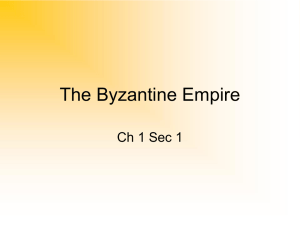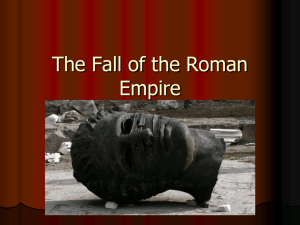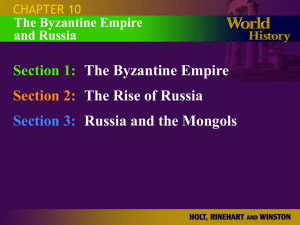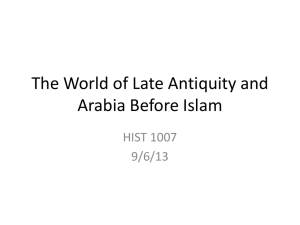13. The Commonwealth of Byzantium
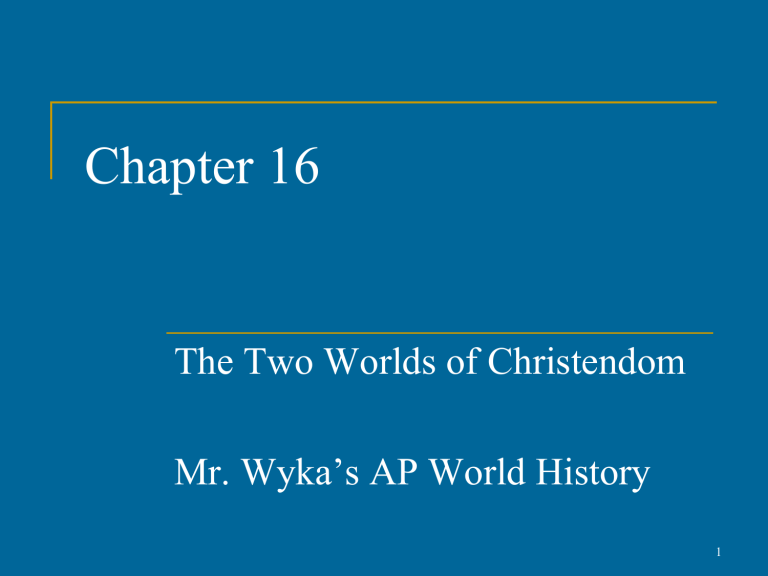
Chapter 16
The Two Worlds of Christendom
Mr. Wyka’s AP World History
1
Medieval Christendom
Two halves
Byzantine empire in the east
Germanic states in the west
Inherited Christianity from Roman empire
After eighth century, tensions between two halves
©2011, The McGraw-Hill Companies, Inc. All Rights Reserved.
2
Successor States to the Roman Empire, ca. 600 C.E.
©2011, The McGraw-Hill Companies, Inc. All Rights Reserved.
3
After the end of the Roman Empire order, the western half of the empire declined and western
Europe de-urbanized, cities turning to villages, villages to fields and forests.
The west also suffered from Germanic invaders, especially the Franks, who took control of large part of Western Europe.
However, the eastern half of the Empire
(Byzantine) survived, despite facing challenges from the growing Muslim world.
4
Early Byzantium, built up by Constantine in the 330s
C.E., was a wealthy, cosmopolitan city, due in part to its location. It contained baths, palaces, and public theaters and fancied itself the “New Rome.”
The government was a civil and religious mix known as caesaropapism , in which the emperor had divine favor and played an active role in church affairs.
The best known of these emperors was Justinian, along with his wife Theodora, was responsible for codifying civil law and attempted to reconstruct the old empire.
5
Caesaropapism
Power centralized in figure of emperor
A Christian ruler cannot claim divinity, so instead, he claims divine authority
Political rule
Involved in religious rule as well
Authority absolute
©2011, The McGraw-Hill Companies, Inc. All Rights Reserved.
6
©2011, The McGraw-Hill Companies, Inc. All Rights Reserved.
7
8
In the west, the Germanic Franks, notably the
Carolingians , exert influence over Western Europe and under Charlemagne create a new empire.
However, with the death of Charlemagne, the empire was divided and was vulnerable to invasion by the new threat, the Vikings.
9
Economically and socially there were vast differences in the east and west.
Constantinople was a powerful and cosmopolitan city at the center of a vast trade network, while the west was experiencing reduced food production and, in urban centers, reduced population.
The Byzantine Empire had silk, a banking system, and its coin, the bezant, was the standard currency for a large portion of the Mediterranean world.
©2011, The McGraw-Hill Companies, Inc. All Rights Reserved.
10
The west was still suffering invasions at this time.
However, a new heavy plow and the use of horse‐power increased food production, and by 900 recovery had begun.
Trade was also growing slowly: the Italians from the south and Norse merchants began following the old Viking routes.
©2011, The McGraw-Hill Companies, Inc. All Rights Reserved.
11
Population Growth of Europe, 200-1000 C.E.
40
35
30
25
20
15
10
5
0
200 400 600 800 900 1000
©2011, The McGraw-Hill Companies, Inc. All Rights Reserved.
Millions
12
The west also saw the development of feudalism , a system of local organization centering around overlapping bonds of loyalty and service.
In feudalism, the peasants (serfs) produced most of what was needed.
With the introduction of new foods and farm technologies, the west began to see an increase in population.
©2011, The McGraw-Hill Companies, Inc. All Rights Reserved.
13
The two halves of Christendom continued to argue over theology and organization. The west had a pope and the east a patriarch.
In the west, Gregory I made the church the only unifying force but the patriarch of Constantinople continued to struggle with the friction caused by caesaropapism . Both churches reach out with missionaries and use monasteries to both help people and create religious communities.
In the end, the differences could not be overcome, and in 1054 a schism in the church occurred, a division that continues into the twenty‐first century.
14
Catholic and Orthodox Churches
The Schism of 1054
Catholic Church – western Europe
Orthodox Church – Byzantine Empire and Russia
15




